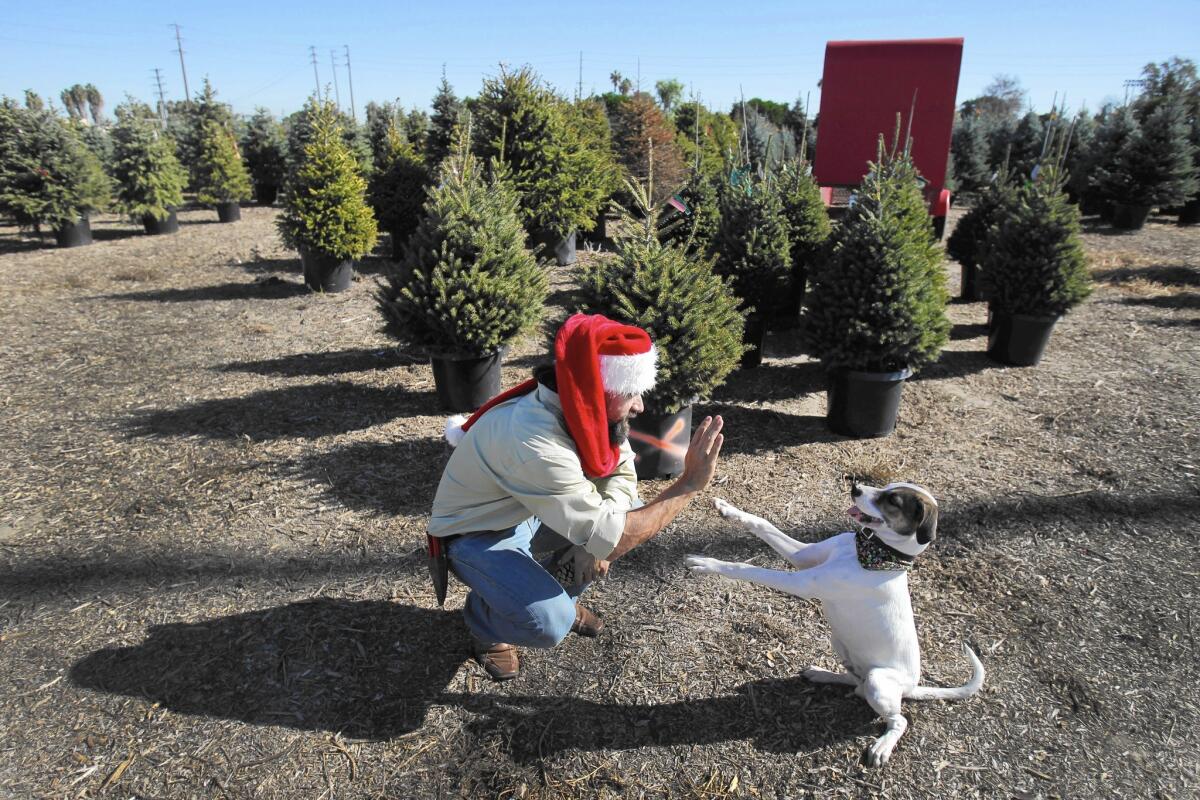Drought saps supply of Christmas trees in California

- Share via
Scott Martin surveys his Christmas trees, inspecting their needles row by row for signs of stress.
The trees in his South Bay nursery differ from those in a typical Christmas tree lot: These are potted living trees, and they’re for rent, not for sale. But all share a thirst that has been difficult to quench as California fights its way through a third year of drought.
This season, customers of Martin’s Living Christmas Co. won’t be seeing as much of the classic Christmas pine, which requires more water than spruce varieties and is more likely to brown in the heat. Living Christmas cut more than 200 pine trees from its roster this season — a 40% reduction in its pine offerings since last year, Martin said.
The company’s drought-conscious move comes as Christmas tree growers struggle with the effects of the state’s lack of rain. This year is on track to be the hottest on record for California, with about 55% of the state under exceptional drought conditions, the most intense level on the drought scale.
“This is one of the driest years that I have seen after 50 years in this business,” said Larry Hyder, who runs Indian Rock Ranch, a Christmas tree farm near Sacramento.
This year was hard on baby trees and seedlings, Hyder said. His farm lost some of those young trees, but the larger, adult trees survived because their water supply comes from roots entwined deep in the ground.
Christmas trees aren’t growing at their usual rate on Ginger Armstrong’s farm in the mountains northeast of Sacramento. Although some interior browning and needle drop-off are normal throughout the year, Armstrong said she’s heard it’s happening more than in previous years.
“We think it’s the drought. We may see the seedlings die off in the next year depending on how much water we get this winter,” said Armstrong, who runs the Snowy Peaks Christmas Tree Farm with her husband, Jim.
The drought is tough on individual farms, but consumers will be spared most of the effects this year, said Rick Dungey, spokesman for the National Christmas Tree Assn.
Although quality can be affected by lack of rain, shoppers shouldn’t worry too much because the trees available each holiday season are at least 6 years old, he said.
“It takes a number of years to get a marketable product,” Dungey said. “With too little rain you can get slow growth rates, but mature trees are hardy and durable.”
In addition, many of the Christmas trees Californians buy are brought by truck or rail car from states that have plenty of rain, such as Oregon and Washington.
The number of Christmas tree growers has been shrinking for years for a variety of reasons. There are only 385 Christmas tree farms in California, down from 400 in 2007, according to 2012 agricultural census data. Of those 385 farms, only 301 cut and sell trees.
Martin, known as “Scotty Claus” during the holiday season, founded Living Christmas in 2008.
The landscape architect rents out live potted trees to households and businesses in Southern California and parts of the Bay Area. Customers can choose from multiple tree sizes and varieties, including cypress, cedar, spruce and pine. Rentals cost $30 to $255, plus delivery fees of $50 to $100.
After the holidays, Martin and his “elves” — they take the seasonal theme very seriously — pick up the trees and nurture them until the next year.
Martin said he loses about 10% of his 3,000-tree crop per season. Some renters don’t care for the trees properly, and not every plant is going to grow as desired.
The company’s most popular tree is the blue spruce — the most drought-tolerant among his crop. That variety often is spoken for by the first week of December, he said. Martin plans to increase the amount of spruce trees available next year, as he phases out less tolerant pines and seeks out a hardier breed.
“We’ve also asked our customers to start using ice cubes,” Martin said. “It’s a more effective way for the tree to absorb the water.”
Despite the drought, business is booming.
The Redondo Beach-based business landed investor Mark Cuban’s support in 2012 when Martin pitched Living Christmas on the ABC show “Shark Tank.”
Since then, Living Christmas has expanded.
The company began operations in parts of San Francisco and the East Bay. It has landed partnerships with Whole Foods Market Inc., Dealer.com and Anchor Brewing Co. The Living Christmas trees are part of a display to promote the brewery’s Christmas ale in more than 100 locations across California, including nearly every Whole Foods, Martin said.
The company also placed 100 trees on the Manhattan Beach Pier for the city’s annual pier lighting ceremony. “Shark Tank,” Martin said, boosted his credibility.
“It used to be ‘He seems like a nice guy, but can he deliver?’ It’s different when you have the owner of the Dallas Mavericks behind you,” Martin said, referring to Cuban.
Though the drought hasn’t caused Living Christmas many problems, the unrelenting Southern California sun has done some damage. Some of the trees have started to brown on the edges from the heat.
Martin said he trimmed his trees later in the season this year because of the above-average heat. With each snip of the pruners, sap oozes out, leaving them susceptible to dangerous pests — better to have a less shapely tree than a sick one, he said.
Martin has other challenges. Lugging trees across Los Angeles and into neighboring Orange County and San Diego is labor intensive. And there is no guarantee of how next year’s crop will turn out.
Because the formula for the perfect Christmas tree differs from customer to customer, Martin is constantly catering to various tastes.
There’s even an area for misfit trees in his nursery, the site of a former Shell Oil refinery. The less-than-perfect trees, some with an odd lean or bald spot, are cheaper to rent — the most expensive costs $130.
Renters get the option to rent the same tree year after year, but sometimes nature has other ideas.
One short tree with its base exposed drew Martin’s attention on a recent morning. The planter had been removed; only a pile of soil remained, wrapped in fraying burlap. The white spruce dried out before it could be sent to the family who had requested it for the previous two years.
“Tiny Tim,” as the family had dubbed it, didn’t make it. But Martin is still optimistic about his other evergreens in the many Christmas seasons that lie ahead.
Twitter: @ParviniParlance
More to Read
Inside the business of entertainment
The Wide Shot brings you news, analysis and insights on everything from streaming wars to production — and what it all means for the future.
You may occasionally receive promotional content from the Los Angeles Times.











